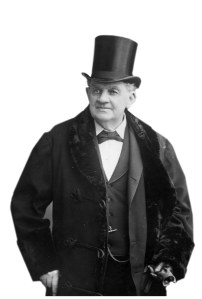
In 1906, Stanford White, the red-mustached playboy starchitect of his day, was shot and killed on the roof of what was then Madison Square Garden, a lavish amphitheater he himself had built. It was already something of a fateful jab at White that some years later the New York Life Insurance Building supplanted his Garden. But in the final karmic punch line, the concrete blot that is today’s Madison Square Garden was unceremoniously plunked atop the site of White’s Penn Station, his most famous ruined creation of all. Or maybe it was a close second. Because to hear the shooter on the roof tell it, White’s propensity for creative destruction wasn’t limited to brick and mortar. The millionaire Harry Thaw shouted, “You ruined my wife!” before firing three shots point-blank at White’s head. (A few witnesses, according to The New York Times‘ account, claimed it was actually “life” instead of “wife.”)
The wife or possibly life in question was Evelyn Nesbit, a chorus girl and model whose It-girl status had been carefully tended by White. He invited the teenager to the right parties, had her teeth fixed and pushed her on his infamous red velvet swing-first with her clothes on and then without. With its grand ballrooms and rooftop gardens all basking in resplendent wealth, Madison Square Garden was the gilded Eden for a budding American plutocracy, and Nesbit, as historian Paula Uruburu aptly put it, played the Garden’s Eve. Seductive, swindled and inevitably fallen, she found herself at the center of what quickly became known as “the crime of the century.”
The sensational murder trial, which dished on the love triangles, drug use and bizarre sexual deviancies of famous millionaires, was the stuff of dreams for the rapidly growing national press. New manufacturing advances had made print cheap and illustrations plentiful. Editors, eager to harness the uncharted potential of their medium, seized on the graphic true-crime drama and filled their pages with images of the stunning damsel Nesbit, cocaine-addled “Mad Harry” and the voluptuary dead man. When Nesbit remarked that she lived “in the everlasting now,” she could have just as easily been pronouncing our collective American fate.
BEFORE IT WAS White’s Garden, Madison Square belonged to the original maestro of spectacle, P.T. Barnum. This was the man who coined the term “show business,” who all but invented media hype, who, at the time of his death, The Washington Post called “the most widely known American that ever lived.” Barnum’s unwieldy trajectory sent him ricocheting from fortune to bankruptcy, slave owning to the abolitionist’s pulpit, carnie life to politics. As an old man, he railed against spiritualist “frauds” despite the fact that he’d spent a lifetime capitalizing on the boundless resiliency of American belief.
It was a career launched when, at the age of 25, Barnum purchased an elderly slave, pried out her teeth, and convinced the public she was the 160-year-old nursemaid of George Washington. He never said, “A sucker is born every minute,” but that was exactly the point. For a man who trafficked in the mythology of his own celebrity as much as any of his “curiosities,” his was a fame entirely manufactured yet so epic, everything stuck.
When the great showman blew in with his Hippodrome, Madison Square Garden was still known as Union Depot, the original terminal of the New York and Harlem Railroad. The property sat beside the marshland that is now Madison Square Park and was once a potter’s field, later a military parade ground, and later still a “House of Refuge” for juvenile delinquents. By 1873, the railroad company had relocated its operations to the newly completed Grand Central, and Barnum snapped up the lease. Over the next decade, the property shape-shifted from bandstand to Wild West show to the gospel revivals of Moody and Sankey, but the biggest act was of course Barnum’s circus.
The night before it opened, in 1881, the whole show paraded up Broadway by torchlight. Overlooking windows, according to one of Barnum’s several autobiographies (all selling in the millions of copies and all unabashedly contradicting one another), went for up to $10 a piece. Barnum declared that half a million spectators witnessed his menagerie of wild beasts quick-stepping to four brass bands, bagpipers and a chorus of jubilee singers. But of more interest to the showman were the roughly 100 newspaper editors from up and down the Eastern seaboard in the audience, whose train fare and hotel lodging he called “a very costly piece of advertising, which yet yielded us a magnificent return.”
Barnum was hardly the first to use the press as his personal ventriloquist’s dummy, but he took new advances in transportation and technology and the potential of celebrity and fashioned it all into a brazen experiment in mass marketing. The report of the New York Evening Telegram was typical of his magnificent returns. “… More natural history can be learned in an hour than in a month from books, and the great museum of living curiosities comprises the most curious specimens of humanity. As for the circus, which is given in three rings, there can no longer be a doubt as to its being the greatest the world ever saw.”
THE SAME YEAR Barnum died, Stanford White commenced work on Madison Square Garden. It was 1891, and the architect was at the peak of his career, widely regarded as the man behind the face of modern Manhattan. Unlike the largely classless religious revivals and big tops that swept Barnum’s Hippodrome, White’s Garden was designed with a more exclusive demographic in mind. The neoclassical palace boasted the world’s largest amphitheater, as well as a swimming pool, a racetrack, a restaurant, a concert hall and a tank for aquatic shows. (“Especially ones in which girls wear skin tights,” White stipulated.) A tower modeled after the Giralda in Seville was perched at one corner, and an elite few kept private apartments there, White naturally being one of them.



